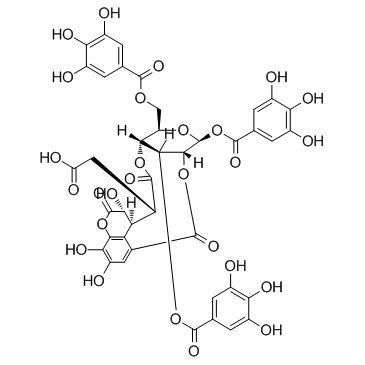Chebulinic acid

(Synonyms: 诃子林鞣酸) 目录号 : GC32250
An ellagitannin with diverse biological activities

Cas No.:18942-26-2
Sample solution is provided at 25 µL, 10mM.
Chebulinic acid is an ellagitannin that has been found in T. chebula and has diverse biological activities.1,2,3,4,5 It is an inhibitor of protein tyrosine phosphatase non-receptor 9 (PTPN9) and PTPN11 (IC50s = 34 and 37 nM, respectively).2 Chebulinic acid (5 ?M) increases glucose uptake in 3T3-L1 preadipocytes. It induces apoptosis of HL-60 and NB4 acute promyelocytic leukemia (APL), but not K562 chronic myelogenous leukemia (CML), cells (IC50s = 7.5, 5, and >60 ?M, respectively).1 Chebulinic acid (25 ?M) reduces the production of reactive oxygen species (ROS) induced by glyceraldehyde-related advanced glycation end products (glycer-AGEs) in human umbilical vein endothelial cells (HUVECs) and reduces glutamate-induced ROS production and cell death in HT22 mouse hippocampal cells.3,4 It inhibits H+/K+-ATPase activity (IC50 = 65.01 ?g/ml) and reduces free and total gastric acidity, as well as increases gastric mucin secretion, in various rat models of gastric ulcer.5
1.Chhabra, S., Mishra, T., Kumar, Y., et al.Chebulinic acid isolated from the fruits of Terminalia chebula specifically induces apoptosis in acute myeloid leukemia cellsPhytother. Res.31(12)1849-1857(2017) 2.Yoon, S.-Y., Kang, H.J., Ahn, D., et al.Identification of chebulinic acid as a dual targeting inhibitor of protein tyrosine phosphatases relevant to insulin resistanceBioorg. Chem.90103087(2019) 3.Lee, H.-S., Koo, Y.-C., Suh, H.J., et al.Preventive effects of chebulic acid isolated from Terminalia chebula on advanced glycation endproduct-induced endothelial cell dysfunctionJ. Ethnopharmacol.131(3)567-574(2010) 4.Song, J.H., Shin, M.-S., Hwang, G.S., et al.Chebulinic acid attenuates glutamate-induced HT22 cell death by inhibiting oxidative stress, calcium influx and MAPKs phosphorylationBioorg. Med. Chem. Lett.28(3)249-253(2018) 5.Mishra, V., Agrawal, M., Onasanwo, S.A., et al.Anti-secretory and cyto-protective effects of chebulinic acid isolated from the fruits of Terminalia chebula on gastric ulcersPhytomedicine20(6)506-511(2013)
| Cas No. | 18942-26-2 | SDF | |
| 别名 | 诃子林鞣酸 | ||
| Canonical SMILES | OC(C[C@H](C(O[C@@]([C@H](O[C@H]1OC(C2=CC(O)=C(O)C(O)=C2)=O)COC(C3=CC(O)=C(O)C(O)=C3)=O)([H])[C@@](OC(C4=CC(O)=C(O)C(O)=C4)=O)([H])[C@@]1([H])OC5=O)=O)[C@@]([C@H]6O)([H])C(C5=CC(O)=C7O)=C7OC6=O)=O | ||
| 分子式 | C41H32O27 | 分子量 | 956.68 |
| 溶解度 | DMSO : 100 mg/mL (104.53 mM; ultrasonic and warming and heat to 60°C) | 储存条件 | 4°C, protect from light |
| General tips | 请根据产品在不同溶剂中的溶解度选择合适的溶剂配制储备液;一旦配成溶液,请分装保存,避免反复冻融造成的产品失效。 储备液的保存方式和期限:-80°C 储存时,请在 6 个月内使用,-20°C 储存时,请在 1 个月内使用。 为了提高溶解度,请将管子加热至37℃,然后在超声波浴中震荡一段时间。 |
||
| Shipping Condition | 评估样品解决方案:配备蓝冰进行发货。所有其他可用尺寸:配备RT,或根据请求配备蓝冰。 | ||
| 制备储备液 | |||
 |
1 mg | 5 mg | 10 mg |
| 1 mM | 1.0453 mL | 5.2264 mL | 10.4528 mL |
| 5 mM | 0.2091 mL | 1.0453 mL | 2.0906 mL |
| 10 mM | 0.1045 mL | 0.5226 mL | 1.0453 mL |
| 第一步:请输入基本实验信息(考虑到实验过程中的损耗,建议多配一只动物的药量) | ||||||||||
| 给药剂量 | mg/kg |  |
动物平均体重 | g |  |
每只动物给药体积 | ul |  |
动物数量 | 只 |
| 第二步:请输入动物体内配方组成(配方适用于不溶于水的药物;不同批次药物配方比例不同,请联系GLPBIO为您提供正确的澄清溶液配方) | ||||||||||
| % DMSO % % Tween 80 % saline | ||||||||||
| 计算重置 | ||||||||||
计算结果:
工作液浓度: mg/ml;
DMSO母液配制方法: mg 药物溶于 μL DMSO溶液(母液浓度 mg/mL,
体内配方配制方法:取 μL DMSO母液,加入 μL PEG300,混匀澄清后加入μL Tween 80,混匀澄清后加入 μL saline,混匀澄清。
1. 首先保证母液是澄清的;
2.
一定要按照顺序依次将溶剂加入,进行下一步操作之前必须保证上一步操作得到的是澄清的溶液,可采用涡旋、超声或水浴加热等物理方法助溶。
3. 以上所有助溶剂都可在 GlpBio 网站选购。
Quality Control & SDS
- View current batch:
- Purity: >98.00%
- COA (Certificate Of Analysis)
- SDS (Safety Data Sheet)
- Datasheet





















